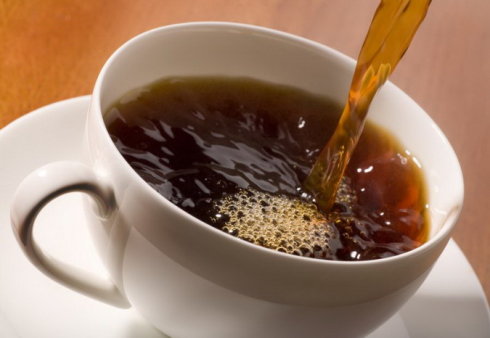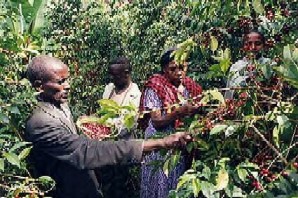World boutique coffee farm beans; Harald mocha (part 1) in Ethiopia has a delicate and rich taste
[product name]: Harald Moka, Ethiopia (Ethiopia Harar Mokha)
[quality rating]: DP Grade 4
[baking degree]: moderate baking is recommended (Medium Roast or City Roast)
[grade]: excellent
[particles]: ★ plump
[acidity]: ★★★★ slightly sour, dark chocolate aftertaste
[equilibrium]: ★★★★ is very stable
[flavor]: very unique, delicate and rich taste, with fruit and wild flavor of the wine.
[coffee producing areas]: sheikh Sheikh (Chercher) region of the highland mountains east of the Darolebu Plain
[raw bean treatment]: sun drying method
Ethiopia is the origin of coffee. Once upon a time, there was a town in southern Ethiopia called Kafa, where there were some red fruits. Shepherds found that the sheep were so excited after eating the fruit that they picked it down and tasted it, so the fruit was picked and cooked by local monks and used as refreshing food for night prayers. It was called "Kafa". Then it was spread all over the world, called "coffee". The legend of the cultivation of coffee and how coffee culture spread around the world has become one of the greatest and most romantic stories in history. Since the discovery of this so-called "devil bean" by shepherds in the Ethiopian desert, they began to chew coffee beans and drink coffee in water. This trend began in Ethiopia and went on an expedition to Arabia, quickly captivating sentient beings and becoming a drink all over the world. To this day, when it comes to coffee, Ethiopians always proudly say, "Coffee is a gift we give to the world."
Ethiopian coffee is known as "wilderness coffee", and a cup of Ethiopian coffee can bring you a primitive experience you've never had before. Ethiopia has unique natural conditions suitable for growing all imaginable varieties of coffee. One of the most famous Ethiopian Harald coffee has a mixed flavor, mellow taste, moderate or mild acidity, and most importantly, it has almost the lowest caffeine content, about 1.13%, and it is a very special kind of coffee. its taste is very aggressive and ready to beat your taste buds, making it hard to forget.
Ethiopian coffee is mostly produced in the plateau above 2000 meters above sea level, with large producing areas such as Djimmah, Gimbi, Yirgacheffe, Sidamo and Harar. Because of the soil conditions, climatic conditions and the altitude of more than 2000 meters in these areas, it has created an ideal environment for the growth of coffee crops. Among them, the Montenegro region of Harald is the only place in the world with wild coffee, which is auctioned in London every year.
When I tasted Ethiopian coffee for the first time, it smelled mellow with a hint of wine, smacked a sip, and the mellow taste immediately refreshed people. This is a typical mocha coffee with medium acid. In short, Ethiopian coffee has a wild flavor and a rich flavor of red wine fermentation. It is not too much to say that it is the best coffee in the world, but it is unknown to the world because of its lack of brand and poor packaging.
Harald's primitive amorous feelings
Harald coffee is a very special kind of coffee, its taste is very aggressive, ready to defeat your taste buds, a cup of Ethiopian Harald coffee can give you a primitive experience you have never had before.
Ethiopia is the first country in the world to grow coffee and maintain the oldest coffee culture. To this day, it is still usually grown on a small scale and maintains very traditional and ancient coffee growing techniques and methods, so pesticides and other chemical fertilizers will never be used, so Ethiopian coffee, like Yemeni mocha coffee, is the best choice for those who advocate nature.
As early as the 6th century, Ethiopian people began to chew coffee and spices together, most often hunters wrapped coffee in bacon as the best dry food, so that they could eat and have the spirit to hunt. So chewing coffee has been handed down as an Ethiopian tradition. By the middle of the 13th century, Ethiopia had been using pans as a tool for roasting coffee, leading the development of coffee culture.
Harald is an ancient city with a long history and one of the four holy cities of Islam. Harald was once the historical capital of Ethiopia. In the era of underdeveloped means of transportation, especially in the era of horses as the main means of transportation, high-quality thoroughbred horses have become the goal that people pursue and aspire to, while Harald in Ethiopia has the best thoroughbred horses in the world. so their initial classification of coffee was that "quality coffee is as important as horses of purebred blood." So the bags of Harald coffee beans we saw still have pictures of horses on them. The appearance and taste of Harald coffee itself can be seen as a high grade.
Harald coffee grows in areas ranging from 900m above sea level in the Darolebu plain to 2700 m in the highland mountain range of Chercher in eastern Ethiopia. These mountains do provide unique characteristics for these perennial coffee beans: the fruit is full and long, moderately acidic, with a typical mocha flavor. Harald coffee is the world's leading high-quality coffee; although the variety is produced abroad, it gives people a friendly feel, smooth and smooth taste, giving people the rich taste of real mocha coffee.
The traditional drying method is still used to produce mocha-Harald (Harrar,Harari,Harer or Harar) at an altitude of about 2,000 meters near the ancient capital of Harrar in the east. Harald has a medium texture with a fruit wine-like flavor, and a good hara is as wild as the best Yemenmoka. Dried beans from other regions, such as Kinby (Gimbi or Ghimbi), Gemma (Jima,Jimma or Djimah) and Sidamo, are equally wild as wine, but less rich in texture and slightly rough. The water-washed mocha from Jinbi in the west has the same sour wine as Hara, but it is packaged with a richer and balanced feel and a thicker texture. As for water-washed beans from the south, such as Sidamo and Gemma, they keep less sour wine and replace them with more gentle and delicate flavours of lemon and flowers. The best is produced in a high and narrow area of Cedar Monai, called Yirgacheffe, whose rich taste brushes the taste buds and leaves endless aftertaste, while the slightly sour taste is similar to Sumatra, swimming under the rich texture; in addition, it adds a unique soft floral fragrance, which is really the only coffee in the world.
Ethiopia in East Africa means "land inhabited by people tanned by the sun" in ancient Greek. Ethiopia's unique cultural tradition, spectacular scenery, pleasant climate, rich animal and plant resources, important places of interest, hospitality and friendly people make it one of the major tourist destinations in Africa. Ethiopia grows coffee in different climatic zones, so it has more than 140 farms and fresh coffee is produced all the year round. The quality of Ethiopian coffee varies according to different elevations and regional ecological environment. The Harar coffee in the southeast highland is a typical Muha coffee with strong aroma; the coffee produced in southwest Wollega has a strong fruity flavor; Limu coffee has wine and spice flavor; Sidamo coffee is mild, full-bodied and sour, while Yirgacheffe coffee has floral flavor. Taste Yega snow coffee, chocolate and sour taste is more intense, like lemon flying, with a trance of flowers.
Ethiopia has unique natural conditions suitable for growing all imaginable varieties of coffee. As a highland crop, Ethiopian coffee beans are mainly grown in areas between 1, 100 and 2300 meters above sea level, roughly distributed in southern Ethiopia. Deep soil, well-drained soil, weakly acidic soil, red soil and soft loam soil are suitable for growing coffee beans because these soils are nutritious and humic. Precipitation is evenly distributed during the seven-month rainy season; during the plant growth cycle, fruits blossom to fruit and crops grow by 90-2700 mm per year, while temperatures fluctuate between 15 and 24 degrees Celsius throughout the growth cycle.
95% of the large coffee production is done by small shareholders, with an average output of 561 kg per hectare. For centuries, minority holders of Ethiopian coffee farms have been producing a variety of high-quality types of coffee. The secret to producing high-quality coffee is that coffee growers have developed a coffee culture in a suitable environment through generations of repeated learning about the coffee growing process, which mainly includes farming methods using natural fertilizers, picking the reddest and fully ripe fruits and processing the fruits in a clean environment. The differences in the quality, natural characteristics and types of Ethiopian coffee all stem from differences in "altitude", "region", "location" and even land types. Ethiopian coffee beans are unique due to their natural characteristics, including "size", "shape", "acidity", "quality", "flavor" and "flavor". These characteristics give Ethiopian coffee a unique natural quality. usually, Ethiopia is always used as a "coffee supermarket" for customers to choose the kind of coffee they like.
Ethiopia produces between 200000 and 250000 tons of coffee each year. Today, Ethiopia has become one of the largest coffee producers in the world, ranking 14th in the world and fourth in Africa. Now, Ethiopia produces coffee not only for drinking, but also for coffee lovers around the world to enjoy it better. With the continuous improvement of the quality and production efficiency of the coffee industry, Ethiopia is now more than ever able to provide high-quality coffee to even the most picky and discriminating customers. Ethiopia hopes that coffee consumers around the world can share Ethiopia's precious wealth.
Source:
The blog of Mermaid Rock
Important Notice :
前街咖啡 FrontStreet Coffee has moved to new addredd:
FrontStreet Coffee Address: 315,Donghua East Road,GuangZhou
Tel:020 38364473
- Prev

World boutique coffee farm beans; Hawaiian Kona coffee (part two) has a charming nutty aroma
[product name] Hawaiian Kona Coffee (Hawaii Kona Coffee) [quality grading]: extra good (Extra Fancy) [roasting degree] it is recommended that deep roasting in roasting degree (High Roast or City Roast) [grade] excellent [granule] ★★★★ is fuller [acidity] ★★ micro acid [balance] ★★★★ is more stable [flavor] smooth, rich, mysterious.
- Next

World boutique Coffee Manor beans: Yega Snow Flavor (part two) Wild Flavor in Ethiopia
[product name]: Ethiopia Ethiopia Yirgacheffe [quality rating]: WP Grade 2 [baking]: recommended moderate baking (Medium Roast or City Roast) [grade]: excellent [granule]: ★ full [acidity]: ★★★★ slightly sour, dark chocolate aftertaste [balance]: ★★★★ is very stable
Related
- Does Rose Summer choose Blue, Green or Red? Detailed explanation of Rose Summer Coffee plots and Classification in Panamanian Jade Manor
- What is the difference between the origin, producing area, processing plant, cooperative and manor of coffee beans?
- How fine does the espresso powder fit? how to grind the espresso?
- Sca coffee roasting degree color card coffee roasting degree 8 roasting color values what do you mean?
- The practice of lattes: how to make lattes at home
- Introduction to Indonesian Fine Coffee beans-- Java Coffee producing area of Indonesian Arabica Coffee
- How much will the flavor of light and medium roasted rose summer be expressed? What baking level is rose summer suitable for?
- Introduction to the characteristics of washing, sun-drying or wet-planing coffee commonly used in Mantenin, Indonesia
- Price characteristics of Arabica Coffee Bean Starbucks introduction to Manning Coffee Bean Taste producing area Variety Manor
- What is the authentic Yega flavor? What are the flavor characteristics of the really excellent Yejasuffi coffee beans?

